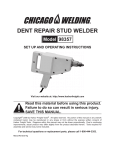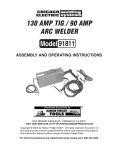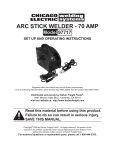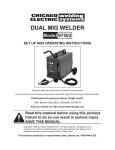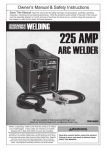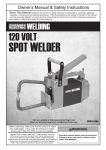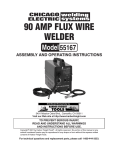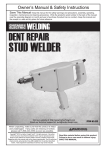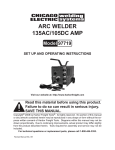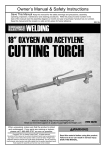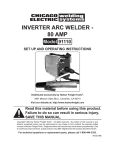Download Chicago Electric 97994 Operating instructions
Transcript
INVERTER PLASMA CUTTER Model 97994 Set up And Operating Instructions Distributed exclusively by Harbor Freight Tools®. 3491 Mission Oaks Blvd., Camarillo, CA 93011 Visit our website at: http://www.harborfreight.com Read this material before using this product. Failure to do so can result in serious injury. Save this manual. Copyright© 2008 by Harbor Freight Tools®. All rights reserved. No portion of this manual or any artwork contained herein may be reproduced in any shape or form without the express written consent of Harbor Freight Tools. Diagrams within this manual may not be drawn proportionally. Due to continuing improvements, actual product may differ slightly from the product described herein. For technical questions or replacement parts, please call 1-800-444-3353. Contents Parts list and assembly diagram���������������������������������� 17 Important SAFETY Information���������������������������� 3 Limited 1 Year / 90 day warranty������������������������������ 18 General Safety Rules�������������� 3 Specific Safety Rules��������������� 5 Specifications�������������������������� 8 PLEASE READ THE FOLLOWING CAREFULLY������� 18 Duty Cycle������������������������������������� 8 Unpacking���������������������������������� 9 Initial Set Up Instructions� 9 Assembly���������������������������������������� 9 CONTROLS & INDICATORS����� 10 Operating Instructions���� 10 Work Piece and Work Area Set Up������������������������������������������ 11 General Operating Instructions���������������������������� 11 PLASMA CUTTING TECHNIQUE13 HOW PLASMA CUTTERS WORK���������������������������������������� 13 Maintenance And Servicing������������������������������� 14 Cleaning, Maintenance, and Lubrication������������������������������� 14 Nozzle Care��������������������������������� 15 Troubleshooting����������������� 16 Cutting arc not stable.��� 16 Plasma Cutter does not function when switched on.����������������������� 16 Weak Arc strength������������ 16 Arc does not ignite.����������� 16 Gas does not flow.������������� 16 SKU 97994 For technical questions, please call 1-800-444-3353. Page 2 NOTICE is used to address practices not related to personal injury. Save This Manual Keep this manual for the safety warnings and precautions, assembly, operating, inspection, maintenance and cleaning procedures. Write the product’s serial number in the back of the manual near the assembly diagram (or month and year of purchase if product has no number). Keep this manual and the receipt in a safe and dry place for future reference. CAUTION, without the safety alert symbol, is used to address practices not related to personal injury. General Safety Rules WARNING! Read all instructions Failure to follow all instructions listed below may result in electric shock, fire, and/or serious injury. Important SAFETY Information In this manual, on the labeling, and all other information provided with this product: 1. a.Keep work area clean and well lit. Cluttered or dark areas invite accidents. This is the safety alert symbol. It is used to alert you to potential personal injury hazards. Obey all safety messages that follow this symbol to avoid possible injury or death. DANGER indicates a hazardous situation which, if not avoided, will result in death or serious injury. WARNING indicates a hazardous situation which, if not avoided, could result in death or serious injury. CAUTION, used with the safety alert symbol, indicates a hazardous situation which, if not avoided, could result in minor or moderate injury. SKU 97994 Work area safety b.Do not operate plasma cutters in explosive atmospheres, such as in the presence of flammable liquids, gases or dust. Plasma cutters create sparks which may ignite the dust or fumes. c. Keep children and bystanders away while operating a plasma cutter. Distractions can cause you to lose control. 2. Electrical safety a.Avoid body contact with grounded surfaces such as pipes, radiators, ranges and refrigerators. There is an increased risk of electric shock if your body is grounded. b.Do not expose plasma cutters to rain or wet conditions. Water entering a plasma cutter will increase the risk of electric shock. For technical questions, please call 1-800-444-3353. Page 3 c. Do not abuse the Power Cord (32). Never use the Cord for pulling or unplugging the plasma cutter. Keep Cord away from heat, oil, sharp edges or moving parts. Damaged or entangled Cords increase the risk of electric shock. d.When operating a plasma cutter outdoors, use an extension cord suitable for outdoor use. Use of a cord suitable for outdoor use reduces the risk of electric shock. 3. Personal safety a.Stay alert, watch what you are doing and use common sense when operating a plasma cutter. Do not use a plasma cutter while you are tired or under the influence of drugs, alcohol or medication. A moment of inattention while operating plasma cutters may result in serious personal injury. b.Use safety equipment. Always wear eye protection. Safety equipment such as arc shaded, impact safety full face shield, dust mask or respirator, heavy-duty work gloves, nonskid safety shoes, or hearing protection used for appropriate conditions will reduce personal injuries. c. Avoid accidental starting. Ensure the Power Switch (11) is in the offposition before plugging in. Plugging in plasma cutters that have the Switch on invites accidents. d.Do not overreach. Keep proper footing and balance at all times. This enables better control of the plasma cutter in unexpected situations. 4. Plasma cutter use and care cutter will do the job better and safer at the rate for which it was designed. b.Do not use the plasma cutter if the Power Switch (11) does not turn it on and off. Any plasma cutter that cannot be controlled with the Switch is dangerous and must be repaired. c. Disconnect the Power Cord (32) from the power source before making any adjustments, changing accessories, or storing plasma cutters. Such preventive safety measures reduce the risk of starting the plasma cutter accidentally. d.Store idle plasma cutters out of the reach of children and do not allow persons unfamiliar with the plasma cutter or these instructions to operate the plasma cutter. Plasma cutters are dangerous in the hands of untrained users. e.Maintain plasma cutters. Check for misalignment or binding of moving parts, breakage of parts and any other condition that may affect the plasma cutter’s operation. If damaged, have the plasma cutter repaired before use. Many accidents are caused by poorly maintained plasma cutters. f. Use the plasma cutter and accessories in accordance with these instructions and in the manner intended for the particular type of plasma cutter, taking into account the working conditions and the work to be performed. Use of the plasma cutter for operations different from those intended could result in a hazardous situation. a.Use the correct plasma cutter for your application. The correct plasma SKU 97994 For technical questions, please call 1-800-444-3353. Page 4 5. Service a.Have your plasma cutter serviced by a qualified repair person using only identical replacement parts. This will ensure that the safety of the plasma cutter is maintained. 6. Avoid unintentional starting. Prepare to begin work before turning on the Inverter Plasma Cutter. 7. Do not leave the Plasma Cutter unattended when it is plugged into an electrical outlet. Turn off the plasma cutter, and unplug it from its electrical outlet before leaving. 8. Use clamps (not included) or other practical ways to secure and support the work piece to a stable platform. Holding the work by hand or against your body is unstable and may lead to loss of control. 9. This product is not a toy. Keep it out of reach of children. Specific Safety Rules 1. Maintain labels and nameplates on the Inverter Plasma Cutter. These carry important safety information. If unreadable or missing, contact Harbor Freight Tools for a replacement. 2. Avoid electric shock. Do not permit electrically live parts, cables, or electrodes to contact skin, clothing, or gloves. Wear ANSI-approved protective clothing. This unit draws enough current to cause serious injury or death. Do not use the Plasma Cutter unless you are insulated from the ground and the work piece. 3. Avoid eye and body damage. Arc rays and infrared radiation can injure eyes and burn skin. Wear ANSI-approved eye and body protection. Do not allow viewing by visitors without proper eye and body protection. Use a Face Shield with arc shaded filter plate. 4. This Plasma cutter requires a dedicated 20 A circuit and NEMA type 5-20R receptacle. 5. Move flammable and explosive material at least 35 feet from the cutting arc to prevent sparks or molten metal from starting a fire. Keep a type ABC fire extinguisher within easy reach. Thoroughly clean the object being cut of any paint, grease, or other foreign material. SKU 97994 10. Industrial applications must follow OSHA guidelines. 11. People with pacemakers should consult their physician(s) before use. Electromagnetic fields in close proximity to heart pacemaker could cause pacemaker interference or pacemaker failure. In addition, people with pacemakers should: • Avoid operating alone. • Do not use with Power Switch locked on. • Properly maintain and inspect to avoid electrical shock. • Any Power Cord must be properly grounded. Ground Fault Circuit Interrupter (GFCI) should also be implemented – it prevents sustained electrical shock. 12. This product, when used for welding, plasma cutting, soldering, or similar applications, produces chemicals known to the State of California to cause cancer and birth defects (or other reproductive harm). For technical questions, please call 1-800-444-3353. Page 5 (California Health & Safety Code § 25249.5, et seq.) 13. Prevent eye injury and burns. Wearing and using ANSI-approved personal safety clothing and safety devices reduce the risk for injury. • Wear ANSI-approved safety impact eye goggles underneath welding eye protection featuring at least a Number 10 shade lens rating. • Leather leggings, fire resistant shoes or boots should be worn when using this product. Do not wear pants with cuffs, shirts with open pockets, or any clothing that can catch and hold molten metal or sparks. • Keep clothing free of grease, oil, solvents, or any flammable substances. Wear dry, insulating gloves and protective clothing. • Wear an approved head covering to protect the head and neck. Use aprons, cape, sleeves, shoulder covers, and bibs designed and approved for welding and cutting procedures. • When welding/cutting overhead or in confined spaces, wear flame resistant ear plugs or ear muffs to keep sparks out of ears. 14. Prevent accidental fires. Remove any combustible material from the work area. • When possible, move the work to a location well away from combustible materials. If relocation is not possible, protect the combustibles with a cover made of fire resistant material. SKU 97994 • Remove or make safe all combustible materials for a radius of 35 feet (10 meters) around the work area. Use a fire resistant material to cover or block all open doorways, windows, cracks, and other openings. • Enclose the work area with portable fire resistant screens. Protect combustible walls, ceilings, floors, etc., from sparks and heat with fire resistant covers. • If working on a metal wall, ceiling, etc., prevent ignition of combustibles on the other side by moving the combustibles to a safe location. If relocation of combustibles is not possible, designate someone to serve as a fire watch, equipped with a fire extinguisher, during the cutting process and for at least one half hour after the cutting is completed. • Do not weld or cut on materials having a combustible coating or combustible internal structure, as in walls or ceilings, without an approved method for eliminating the hazard. • Do not dispose of hot slag in containers holding combustible materials. Keep a fire extinguisher nearby and know how to use it. • After cutting, make a thorough examination for evidence of fire. Be aware that easily-visible smoke or flame may not be present for some time after the fire has started. Do not weld or cut in atmospheres containing dangerously reactive or flammable gases, vapors, liquids, and dust. Provide adequate ventilation in work areas to prevent accumulation of flammable gases, For technical questions, please call 1-800-444-3353. Page 6 vapors, and dust. Do not apply heat to a container that has held an unknown substance or a combustible material whose contents, when heated, can produce flammable or explosive vapors. Clean and purge containers before applying heat. Vent closed containers, including castings, before preheating, welding, or cutting. 14. Do not touch live electrical parts. Wear dry, insulating gloves. Do not touch electrode or conductor tong with bare hand. Do not wear wet or damaged gloves. 15. Protect yourself from electric shock. Do not use outdoors. Insulate yourself from the work piece and ground. Use nonflammable, dry insulating material if possible, or use dry rubber mats, dry wood or plywood, or other dry insulating material big enough to cover your full area of contact with the work or ground. 16. Ensure that the unit is placed on a stable location before use. If this unit falls while plugged in, severe injury, electric shock, or fire may result. 17. Never remove the grounding prong or modify the Power Cord Plug in any way. Do not use adapter plugs with this product. 18. Avoid overexposure to fumes and gases. Always keep your head out of the fumes. Do not breathe the fumes. Use enough ventilation or exhaust, or both, to keep fumes and gases from your breathing zone and general area. • Where ventilation is questionable, have a qualified technician take SKU 97994 an air sampling to determine the need for corrective measures. Use mechanical ventilation to improve air quality. If engineering controls are not feasible, use an approved respirator. WARNING Inhalation Hazard: Welding and Plasma Cutting Produce toxic fumes. Exposure to welding or cutting exhaust fumes can increase the risk of developing certain cancers, such as cancer of the larynx and lung cancer. Also, some diseases that may be linked to exposure to welding or plasma cutting exhaust fumes are: •Early onset of Parkinson’s Disease •Heart disease • Ulcers •Damage to the reproductive organs •Inflammation of the small intestine or stomach • Kidney damage •Respiratory diseases such as emphysema, bronchitis, or pneumonia Use natural or forced air ventilation and wear a respirator approved by NIOSH to protect against the fumes produced to reduce the risk of developing the above illnesses. • Follow OSHA guidelines for Permissible Exposure Limits (PEL’s) for various fumes and gases. • Follow the American Conference of Governmental Industrial Hygienists recommendations for Threshold Limit Values (TLV’s) for fumes and gases. For technical questions, please call 1-800-444-3353. Page 7 • Have a recognized specialist in Industrial Hygiene or Environmental Services check the operation and air quality and make recommendations for the specific welding or cutting situation. 19. Live torch when Trigger is pressed. Keep Torch away from people and flammables before touching Trigger. 20. Turn off, unplug, and discharge electrode to ground before performing any inspection, maintenance, or cleaning. 21. Use only compressed air at between 30 and 35 PSI. Never use oxygen, carbon dioxide, combustible gases or any bottled gas as an air source for the Plasma Cutter. Such gases are capable of explosion and serious injury to people. 22. The brass components of this product contain lead, a chemical known to the State of California to cause birth defects (or other reproductive harm). (California Health & Safety code § 25249.5, et seq.) 23. The warnings, precautions, and instructions discussed in this instruction manual cannot cover all possible conditions and situations that may occur. It must be understood by the operator that common sense and caution are factors which cannot be built into this product, but must be supplied by the operator. Save these instructions. Specifications Electrical Requirements 120 V~ / 60 Hz / 19 A Output 5-13 A Duty Cycle 40% @ 13 A, 60% @ 10 A, 100% @ 8 A Control Mode IGBT Inverter Air Pressure 30~35 PSI Maximum Cutting Capacity 1/ ” Clean Cut Steel; 8 3/ ” Sever Cut Steel; 16 1/ ” Stainless Steel, Aluminum, 16 or Brass Copper Arc Striking System Pilot Start (5 Second Intervals) LED Indicators Power On: Green LED Light Cutting in Process: Yellow LED Light Unit Overheating: Red LED Light Note: This Plasma cutter requires a dedicated 20 A circuit and NEMA type 5-20R receptacle. Duty Cycle Duty Cycle is the equipment specification which defines the number of minutes within a 10 minute period that a piece of equipment can safely operate. This Plasma Cutter has a 60% duty cycle at 10 Amps, which means that it may be used only 6 minutes at 10 Amps out of any 10 minute period, and must be rested the remaining 4 minutes. CAUTION: Failure to observe the duty cycle limitations of this Plasma Cutter can easily damage the equipment, and will void the warranty. Unpacking When unpacking, check to make sure that the item is intact and undamaged. If any parts are missing or broken, please call Harbor Freight Tools at the number shown on the cover of this manual as soon as possible. REV 09a SKU 97994 For technical questions, please call 1-800-444-3353. Page 8 Initial Set Up Instructions Regulator Nut Read the entire Important Safety Information section at the beginning of this manual including all text under subheadings therein before set up or use of this product. To prevent serious injury from accidental operation: Turn the Power Switch (11) of the Plasma Cutter to its “OFF” position and unplug the plasma cutter from its electrical outlet before assembling or making any adjustments to the plasma cutter. Loop Regulator Body 2. Slide the Regulator Body up through the Loop on the back of the Cutter and attach in place with the Regulator Nut as shown in the illustration above. The Loop is keyed so that the Regulator should only align in one position. Note: For additional information regarding the parts listed in the following pages, refer to the Assembly Diagram near the end of this manual. Regulator Body Assembly 1. Air Line Remove the Regulator Nut from the top of the Regulator Body. connector 3. Attach the Air Line to the connector on the side of the Regulator Body. The connector is designed to securely hold the line after inserting. Gently pull on the line to ensure it is firmly held. REV 09a SKU 97994 For technical questions, please call 1-800-444-3353. Page 9 CONTROLS & INDICATORS FIGURE B POTENTIOMETER KNOB (10) AIR PRESSURE REGULATOR (33) AIR PRESSURE GAUGE FIGURE C POWER SWITCH (11) ON = GREEN LED CUTTING = YELLOW LED OVERHEATING = RED LED MALE QUICK RELEASE ADAPTER CIRCUIT BREAKER (30) 4. 5. A male Quick Release Adapter is mounted on the Air Pressure Regulator (33) at the rear of the Plasma Cutter. Attach your compressor’s air supply hose to the Quick Release Adapter. Then, adjust your compressor to deliver 30 to 35 PSI compressed air. (See Figure B.) During operation, you can regulate air pressure through the Plasma Cutter by adjusting the Knob located on the Air Pressure Regulator (33). (See Figure B.) SKU 97994 1. Power Switch (11): Up (I) is “ON”, down (O) is “OFF”. (See Figure C.) 2. Potentiometer Knob (10): Allows you to adjust the current from 5 to 13 Amps. (See Figure C.) 3. Green LED Light: When illuminated, means the Plasma Cutter is on. (See Figure C.) 4. Yellow LED Light: When illuminated, means cutting is in process. (See Figure C.) 5. Red LED Light: When illuminated, means the Plasma Cutter has become overheated and the unit will automatically shut down. Stop using the Plasma Cutter while leaving the Power Switch (11) ON to allow the cooling Fan to operate. The LED Light will turn off automatically when the unit cools down and then you may resume cutting. (See Figure C.) For technical questions, please call 1-800-444-3353. Page 10 Operating Instructions General Operating Instructions Protective gear must be worn when using the Plasma Cutter. ANSI-approved, arc shaded, eye protection, a full face shield, heavy-duty work gloves, a welding apron, respirator, and heavy-duty work clothes without pockets should be worn when using this product. Do not look at the ignited arc without eye protection. Light from the arc can cause permanent damage to the eyes. Light from the arc can burn the skin. Do not breathe arc fumes. Read the entire Important Safety Information section at the beginning of this manual including all text under subheadings therein before set up or use of this product. To prevent serious injury from accidental operation: Turn the Power Switch (11) to its “OFF” position before performing any inspection, maintenance, or cleaning procedures. Work Piece and Work Area Set Up 1. Designate a work area that is clean and well-lit. The work area must not allow access by children or pets to prevent injury and distraction. 2. Route the Power Cord (32) along a safe route to reach the work area without creating a tripping hazard or exposing the Power Cord to possible damage. The Power Cord must reach the work area with enough extra length to allow free movement while working. 3. 4. There must not be hazardous objects, such as utility lines or foreign objects, nearby that will present a hazard while working. A barrier, such as a welding curtain or welding shroud should be put up to protect others in the work area and limit the spray of sparks. SKU 97994 1. IMPORTANT: The duty cycle defines the number of minutes, within a 10 minute period, during which a given Plasma Cutter can safely produce a particular current. For example, this Plasma Cutter, with a 60% duty cycle at 10 Amps (maximum setting), must be allowed to rest for at least 4 minutes after every 6 minutes of continuous cutting at 10 Amps. • Failure to carefully observe duty cycle limitations can stress a Plasma Cutter’s power generation system, contributing to premature plasma cutter failure. • This Plasma Cutter is equipped with an internal thermal protection system to help prevent damage to the unit. When the unit overheats; it automatically shuts down, then returns to service when it cools down. • Once the unit returns to service, follow a more conservative duty cycle For technical questions, please call 1-800-444-3353. Page 11 routine to help prevent excess wear to the Plasma Cutter. 2. Mount the metal to be cut to the metal welding/cutting table. It should be mounted so that the cutting debris falls to the cement floor. 3. Place the Plasma Cutter unit no closer than 6 feet from the workpiece to be cut. 4. Adjust the Knob on the Air Pressure Regulator (33) to regulate the air supply between 30 and 35 PSI as indicated on the Air Pressure Gauge. The air supply must be dry. It is recommended to install a moisture filter (not included) on the compressor. Do not use an air oiler. (See Figure B.) 5. Securely place the clamping end of the Earth Clamp (14) to a part of the workpiece or metal table that is clean of paint, oil, or dirt. Clamp as close as possible to the workpiece without damaging the Cable during cutting. 6. Set the desired current (5~13 Amps) for the type of metal being cut with the Potentiometer Knob (10). Thin metals use low current and heavy metals use high current. (See Figure C.) 7. Turn the Power Switch (11) OFF (O), then plug the Plasma Cutter’s Power Cord (32) into a dedicated, 120 V~, 20 A, electrical outlet with delayed action type circuit breaker or fuse. (See Figure C.) 8. Hold the Cutting Torch (13) firmly. WARNING! The Torch is “live” when its Trigger is pressed. Keep the Torch away from people and flammables before touching Trigger. 9. When everything is in place for cutting, press the Power Switch up to its “ON” position. The GREEN “Power On” Light will illuminate. (See Figure C.) 10. WARNING! To prevent serious injury, point torch away from your body when squeezing trigger. Once the Trigger is squeezed, the arc will ignite. This unit provides a pilot arc, so allow you to start an arc against the workpiece. The pilot arc lasts only a few seconds. 11. Squeeze the Trigger to energize the Cutting Torch (13), the YELLOW “Cutting” LED will illuminate. Do not to touch anything else with the Torch except the workpiece to be cut. (See Figure C.) 12. Maintain the tip of the torch within 1/16” from the workpiece. If the tip is too far from the workpiece, the arc will go out. 13. Slowly move the Cutting Torch (13) at a slight angle along the cutting line with the Torch tip trailing. The air causes the molten metal to fall away from the workpiece being cut. If proper cutting is not achieved, adjust the Potentiometer Knob (10) to a higher level and/or increase air flow. (See Figure C.) Note: If too much current is drawn from the Plasma Cutter, the thermal protector will activate and the RED “Overheating” LED will illuminate. The Plasma Cutter will automatically shut down until it cools, then you may resume cutting again. REV 09a SKU 97994 For technical questions, please call 1-800-444-3353. Page 12 Note: If the input current is too high for the Plasma Cutter, the overload protector will activate and the cutter will stop working. To reset, press the Circuit Breaker (30) to begin cutting again. (See Figure D.) 14. When finished cutting: 3. Set the air pressure between 30 and 35 PSI. Increased air pressure will increase plasma speed and cutting pressure. Air pressure and amperage should be adjusted in tandem. 4. Start with a mid-range amperage setting (10 amps) and adjust up or down from there. Increased amperage will increase cutting heat. This is needed with heavier and harder metals. However, increased amperage will reduce duty cycle time. 5. Move the Cutting Head more slowly for thicker and harder metals, and more quickly for thin or soft metals. Keep the Cutting Head moving while cutting. • Release the Trigger on the Cutting Torch (13) and lift the Torch from the workpiece. Note: The air will continue to flow through the end of the torch for about 20 seconds to allow it to cool. • Press the Power Switch (11) to its “OFF” position. • Set the Cutting Torch (13) down on the metal workbench. • Turn off the air supply. • Unplug the Power Cord (32) from its electrical outlet. • Allow all components of the Plasma Cutter to completely cool. Then store the unit indoors out of children’s reach. PLASMA CUTTING TECHNIQUE 1. Using a Plasma Cutter is a skill that requires time and effort to do well. Practice striking and maintaining an arc on scrap workpieces before beginning work. This will help you gauge the best settings for the Plasma Cutter for the material at hand. 2. You can cut any metal that will conduct electricity up to approximately 0.196” (5mm) thick mild steel or equivalent. Very thin or very thick metals are more difficult to cut cleanly. SKU 97994 For technical questions, please call 1-800-444-3353. REV 09a Page 13 Maintenance And Servicing WARNING! If the Power Cord (32) of this Plasma Cutter is damaged, it must be replaced only by a qualified service technician. Procedures not specifically explained in this manual must be performed only by a qualified technician. Nozzle Care 1A 3A To prevent serious injury from accidental operation: Turn the Power Switch (11) of the Plasma Cutter to its “OFF” position and unplug the plasma cutter from its electrical outlet before performing any inspection, maintenance, or cleaning procedures. To prevent serious injury from plasma cutter failure: Do not use damaged equipment. If abnormal noise or vibration occurs, have the problem corrected before further use. Cleaning, Maintenance, and Lubrication 1. BEFORE EACH USE, inspect the general condition of the Plasma Cutter. Check for loose screws, cracked or broken parts, damaged electrical wiring, and any other condition that may affect its safe operation. 2. After Use, clean external surfaces of the plasma cutter with clean cloth. 3. Periodically, using compressed air, blow out all dust and debris from the interior. SKU 97994 4A 5A 6A 7A FIGURE E 2A Part Description 1A Handle 2A Trigger 3A Body 4A Electrode 5A Insulating Diffuser 6A Nozzle 7A Nozzle Holder 1. Turn the Nozzle Holder (7A) counterclockwise while pulling to remove. (See Figure E.) 2. Scrub the interior of the Nozzle Holder (7A) and Nozzle (6A) clean with a wire brush. (See Figure E.) 3. Examine the end of the Nozzle (6A). The end should be flat and even. If the end is uneven, chipped, melted, cracked, or otherwise damaged, the Nozzle will adversely effect the weld and should be replaced. (See Figure E.) 4. Replace the Nozzle Holder (7A) after inspecting, cleaning, and re-installing the Nozzle (6A), Insulating Diffuser (5A), and Electrode (4A). (See Figure E.) 5. Check the Torch carefully for proper operation. For technical questions, please call 1-800-444-3353. Page 14 Troubleshooting To Prevent serious injury: Shut off the Welder, disconnect it from power, and discharge the torch to ground before adjusting, cleaning, or repairing the unit. Cutting arc not stable. • Possible Causes and Solutions: • Loose Cutting Torch (13) cable or Earth Clamp (14) cable: Check to ensure that all connections are tight. • Damaged Cutting Torch (13) or loose connection within Torch: Have a qualified technician inspect and repair/replace as necessary. Plasma Cutter does not function when switched on. • Possible Causes and Solutions • Tripped thermal protection device: Allow the unit to cool until the RED “Overheating” LED goes off, then resume use. Reduce duration or frequency of cutting periods to help reduce wear on the Plasma Cutter and frequency of overheating. • Faulty Power Switch (11): Have a technician repair/replace Power Switch. • Internal fuse blown: Have a qualified technician check/replace. ficient, have a licensed electrician remedy the situation. Arc does not ignite. • Possible Causes and Solutions: • Improper ground connection: Make certain that the work piece is contacted properly by the Earth Clamp (14) and that the work piece is properly cleaned near the Earth Clamp and the welding location. • Improperly sized or excessively worn Nozzle (6A): Verify that Nozzle is the proper size for the Cutting Torch used. Check that the hole in the tip is not deformed, enlarged, or dirty. If needed, replace Nozzle with proper size and type. Air does not flow. • Possible Causes and Solutions: • Nozzle (6A) Plugged: Clean Nozzle. If damaged, replace. • Air Pressure Regulator (33) closed: Make sure Regulator is adjusted properly. • Air supply hose blocked: Check air supply hose, and hose within Cutting Torch (13) cable. Plasma Cutter continually overheats. • Possible Causes and Solutions • Input voltage too high or too low. Have electrician inspect and service building electrical circuit. Weak Arc strength • Possible Cause and Solution: • Incorrect line voltage: Check the line voltage and, if insufREV 09a SKU 97994 For technical questions, please call 1-800-444-3353. Page 15 Parts list and assembly diagram Part Qty. Part 1 Screw (M5x14) & Nut (M5) Description 2 18 Inductance Description Qty. 1 2 Handle 1 19 Transformer 1 3 Pothook 2 20 Radiator 3 4 Steel Cover 1 21 LED 3 5 Fan 1 22 Potentiometer 1 6 Tapping Screw (2.0x6) 6 23 Temperature Control 1 7 Panel Fixation 1 24 Electromagnetism Valve 1 8 Panel Fixation 1 25 PCB Support 1 9 Plastic Front Cover 1 26 PCB 1 10 Potentiometer Knob 1 27 Wind Pipe 1 11 Power Switch 1 28 Capacitor 4 12 Cutting Holder Jacket 1 29 Plastic Back Cover 1 13 Cutting Torch 1 30 Circuit Breaker 1 14 Earth Clamp 1 31 Cable Clip 1 15 Earth Clamp Connector (PG11) 1 32 Power Cord 1 16 Tapping Screw (4.2x9.5) 13 33 Air Pressure Regulator 1 17 Steel Base 1 34 Bolt (M5x12) & Nut (M5) 2 SKU 97994 For technical questions, please call 1-800-444-3353. Page 16 Limited 1 Year / 90 day warranty Harbor Freight Tools Co. makes every effort to assure that its products meet high quality and durability standards, and warrants to the original purchaser that for a period of ninety days from date of purchase that the torch, liner, wire feed mechanism (if applicable), welding clamps, electrode holders, cables and accessories packed with the welder are free of defects in materials and workmanship. This Limited 90 Day/1 Year Warranty shall not apply to consumable parts such as tips, welding wire, and gas nozzles. Harbor Freight Tools also warrants to the original purchaser, for a period of one year from date of purchase, that the transformer and rectifier are free from defects in materials and workmanship (90 days if used by a professional contractor or if used as rental equipment). This warranty does not apply to damage due directly or indirectly to misuse, abuse, negligence or accidents, repairs or alterations outside our facilities, normal wear and tear, or to lack of maintenance. We shall in no event be liable for death, injuries to persons or property, or for incidental, contingent, special or consequential damages arising from the use of our product. Some states do not allow the exclusion or limitation of incidental or consequential damages, so the above limitation of exclusion may not apply to you. This warranty is expressly in lieu of all other warranties, express or implied, including the warranties of merchantability and fitness. To take advantage of this warranty, the product or part must be returned to us with transportation charges prepaid. Proof of purchase date and an explanation of the complaint must accompany the merchandise. If our inspection verifies the defect, we will either repair or replace the product at our election or we may elect to refund the purchase price if we cannot readily and quickly provide you with a replacement. We will return repaired products at our expense, but if we determine there is no defect, or that the defect resulted from causes not within the scope of our warranty, then you must bear the cost of returning the product. This warranty gives you specific legal rights and you may also have other rights which vary from state to state. 3491 Mission Oaks Blvd. • PO Box 6009 • Camarillo, CA 93011 • (800) 444-3353 Record Product’s Serial Number Here: Note: If product has no serial number, record month and year of purchase instead. Note: Some parts are listed and shown for illustration purposes only, and are not available individually as replacement parts. PLEASE READ THE FOLLOWING CAREFULLY The manufacturer and/or distributor has provided the parts list and assembly diagram in this manual as a reference tool only. Neither the manufacturer or distributor makes any representation or warranty of any kind to the buyer that he or she is qualified to make any repairs to the product, or that he or she is qualified to replace any parts of the product. In fact, the manufacturer and/ or distributor expressly states that all repairs and parts replacements should be undertaken by certified and licensed technicians, and not by the buyer. The buyer assumes all risk and liability arising out of his or her repairs to the original product or replacement parts thereto, or arising out of his or her installation of replacement parts thereto. SKU 97994 For technical questions, please call 1-800-444-3353. Page 17

















